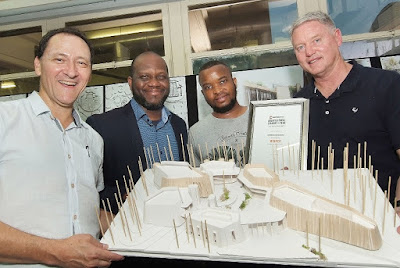(Lawrence Ogunsanya
Academic Leader, Architecture, University of KwaZulu-Natal;
Juan Solis-Arias,
Master of Architecture 2nd year coordinator. Lecturer of Architecture,
University of KwaZulu-Natal; winner Siyabonga Khuzwayo & Chris Mungle, Corobrik
Sales Manager eThekwini)
Siyabonga Khuzwayo from the University of KwaZulu-Natal wins the 33rd
annual Corobrik Regional Architecture Award
Architecture has the profound ability to capture a particular moment in
history, reflecting the various interests, beliefs and unique character of a
place in time through form and material. The design of such legacy-defining
structures is perfectly represented at this year’s Corobrik regional
architecture award.
This year it was announced that Siyabonga Khuzwayo from the University
of KwaZulu-Natal was the regional winner of this sought-after award. Commenting
on the Corobrik Architectural Student of the Year Award, Musa Shangase,
Corobrik Commercial Director said: “As an organisation, we believe that ‘better
starts here’ and this is particularly true for this award. These up-and-coming
young architects are already designing iconic structures that would imprint
their legacy on the country’s built environment. It is truly an honour to
witness history being made.”
For the Corobrik Regional Architecture Award, Siyabonga Khuzwayo
received R10,000, with Kireshen Chetty taking home the second-prize of R8,000,
and Mthokozisi Sibisi receiving R6,000 for third place. A further R6,000 was
awarded to Mbuso Msipho for the innovative use of clay masonry in the building
design.
Khuzwayo is one of eight young architects from top South African universities
receiving a Corobrik Regional Architecture Award in recognition of their design
talent and innovation throughout 2019. In addition to the cash prize, the
regional competition winners are through to the finals of the National
Architectural Student of the year Award – set to be announced in Johannesburg
on May 6, 2020 – which comes with R70,000 in prize money.
Siyabonga Khuzwayo’s dissertation is entitled Exploring the influence of traditional healing practice to space and
form: A design towards a traditional
healing centre in KZN.
This thesis focuses on deciphering the notion of traditional healing, to
ascertain how architectural design can become a medium to promote the
traditional healing entity. This will change the negative connotation associated
with traditional healing, African indigenous values, cultures and beliefs. The
aim of the study is to design a building typology that will provide a platform
for traditional healers to network, transfer skills, and engage with the
general public.
Second place Kireshen Chetty – Fashion
and social change as a catalyst for Architectural Design, A proposed fashion
innovation centre in Clairwood, Durban. Chetty says, “Within the context of
globalising urban cities, this dissertation aims to investigate and explore the
means and methods of cultural integration through the commonality of fashion. A
collaboration of science, fashion, architecture and art is the basis used to
combat the repercussions and wounds inflicted by apartheid and post-apartheid,
mainly segregation and xenophobia. This proposed fashion innovation centre in
Clairwood, Durban is self-sustainable and aids in skill development and
regeneration within the community.
Third-placed Mthokozisi Sibisi’s thesis is entitled: Exploring the benefits of recycling in low income settlements: A
design of a socially inclusive recycling collection centre in Bisasar road
informal settlements, Durban. The project is a recycling collection centre
with a buy-back centre as primary functions with educational, social and
business elements as supporting secondary functions. It will generate income
for people working at the facility.
The best use of clay award was presented to Mbuso Msipho’s thesis entitled
Identity and Memory as a generator of
Architecture.
Shangase added that it was “Enlightening to see a generation of new
architects showcasing world-class design talent. The designs by the winners of
Corobrik Regional Architecture Award are an example of the start of
legacy-enduring structures that will connect future generations with our
current-day experiences. When it comes to creating a legacy in architecture,
it’s best to rely on honest, simple materials that inform the architectural
language without overpowering the finished product.”
He concluded that “Corobrik’s clay brick range is a really impactful
example of this, linking our past to our present and inspiring our future.
Better starts here - with Corobrik.”












